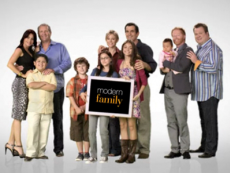
The ritual of watching television as a family has been an integral part of Western culture since the 1950s when television was popularised. Of course, the cornerstone of family television is situational comedy, or 'sitcoms': relevant, true to real life, and usually containing a relatable family dynamic. This comparison between the 'real world' family, and the family on the television screen, is typically what makes these programs so enjoyable, each hilarious misunderstanding of the mundane life inspiring a recollection of what dad did last week, or how so-and-so was worried about their parents finding out about their bad grades. The clear change in style of family in popular sitcoms throughout the years can be used as a cultural marker, to depict how attitudes, and society has changed.
One of the first sitcoms was "I Love Lucy" (1951-57). True to the fifties, it featured a very traditional family—wife and protagonist Lucy Ricardo, her husband Ricky Ricardo, a singer, and son Ricky Ricardo Jr. Right down to the name of the child, this show is traditional to a T. Of course, reoccurring characters such as Landlord Fred and his wife Ethel made occasional appearances, but the main focus was on the core American family. Despite sounding slightly dull the show, at its height, had 50.9 million viewers enjoying the antics of Lucy and her friends. The female protagonist is forward thinking, for the era, and acts as a precursor to the Women's Liberation Movement of the 1960s. The growth and change from the nuclear family (mother, father, child), however, leads on to the next big sitcom of the late 20th century.
"The Brady Bunch" aired from 1969 to 1974, and followed the story of the titular Brady family. As the swinging sixties hit, TV companies realised that families were no longer comprised of two parents and a child, leading to the Bradys. Mike Brady and his three sons have their lives turned upside-down when widower Mike marries divorced Carol, who brings her three daughters with her. An eight-member family comprised of a divorcee and a widower demonstrates a slightly wider scope of what was then the 'typical' Western family. Despite only running for five years, and never receiving any outstanding critical reception, the fact that almost everyone over twenty recognises the name of the show proves its impact on Western culture.
The next step in society's evolution of the family sitcom was The Cosby Show's Huxtables. This was not only the first time a black family had been the protagonists of a family show, but the wife's employment as a lawyer was also a groundbreaking decision. The show not only offered relatable humour, but also dealt with serious issues, such as child dyslexia, and teen pregnancy. Its eight season run, and at one point 20.6 million viewer rating, demonstrates how popular a modern, more varied family truly was.
This leaves us with one very "Modern Family". Developed by Christopher Lloyd and Steven Levitan, this follows the life of the Dunphy-Tucker-Delgado-Pritchett's, one family split into three nuclear groups. Jay Pritchett is the patriarch, with second wife Gloria Delgado-Pritchett, stepson Manny Delgado, and son Joe Delgado-Pritchett. Jay's daughter from his first marriage, Claire, stems off into another family, with her husband Phil Dunphy, daughters Hayley and Alex, and son Luke. Jay's son, and Claire's brother Mitchell, is part of a third family, with husband Cameron Tucker, and daughter Lily Tucker-Pritchett. This complicated, loving mess of a family unit is representative of today's modern family: with multiple children, stepchildren, and only children; with straight and gay parents; and with love. The multiple awards and high critical praise signify the strong positive reception the show has received.
As time passes, television shows seem to constantly reflect the modern family audience, in order to provide viewers with a relatable plot line. These constant steps towards liberalisation in the television family prove how far our society and culture has come, and hopefully signify an even more accepting and loving future.
Image: https://upload.wikimedia.org/wikipedia/en/b/b0/Modern-Familytigtlecard.jpg

0 Comment:
Be the first one to comment on this article.